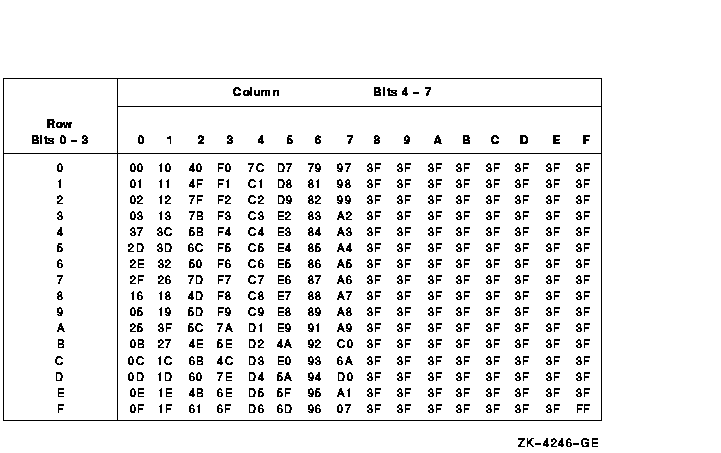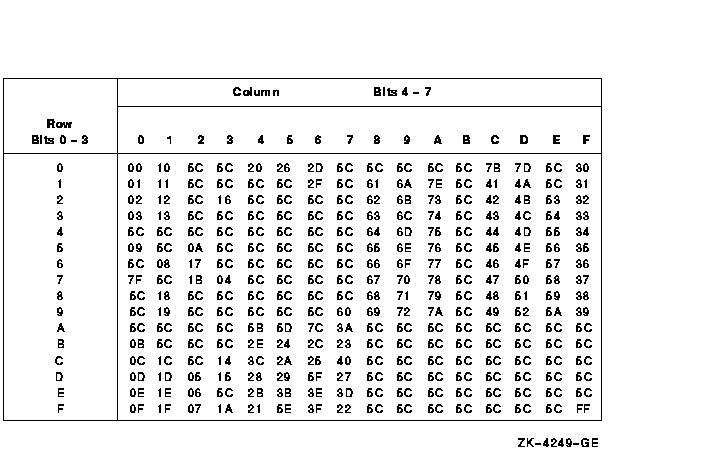 |
HP OpenVMS systems documentation |
| Previous | Contents | Index |
The Traverse a Balanced Binary Tree routine calls an action routine for each node in a binary tree.
Note
No support for arguments passed by 64-bit address reference or for use of 64-bit descriptors, if applicable, is planned for this routine.
LIB$TRAVERSE_TREE treehead ,user-action-procedure [,user-data-address]
OpenVMS usage: cond_value type: longword (unsigned) access: write only mechanism: by value
treehead
OpenVMS usage: address type: address access: read only mechanism: by reference
Tree head of the binary tree. The treehead argument is the address of an unsigned longword that is the tree head in the binary tree traversal.user-action-procedure
OpenVMS usage: procedure type: procedure value access: function call (before return) mechanism: by value
User-supplied action routine called by LIB$TRAVERSE_TREE for each node in the tree. The user-action-procedure argument must return a success status for LIB$TRAVERSE_TREE to continue traversal.For more information, see Call Format for an Action Routine in the Description section.
user-data-address
OpenVMS usage: user_arg type: longword (unsigned) access: read only mechanism: by reference
User data that LIB$TRAVERSE_TREE passes to your action routine. The user-data-address argument contains the address of this user data. This is an optional argument; the default value is 0.
LIB$TRAVERSE_TREE calls a user-supplied action routine for each node to traverse a balanced binary tree.Call Format for an Action Routine
The format of the call is as follows:
user-action-procedure node ,user-data-address
LIB$TRAVERSE_TREE passes the node and user-data-address arguments to your action routine by reference.
This action routine is defined by you to fit your own purposes. A common use of an action routine here is to print the contents of each node during the tree traversal.
The following is one example of a user-supplied action routine.
struct Full_node { void* left_link; void* right_link; short reserved; char Text[80]; }; static long Print_Node(struct Full_node* Node, void* dummy) { /* ** Print the string contained in the current node */ printf("%s\n", Node->Text); return LIB$_NORMAL; }
LIB$_NORMAL Routine successfully completed.
Any condition value returned by your action routine.
The C example provided in the description of LIB$INSERT_TREE also demonstrates the use of LIB$TRAVERSE_TREE. Refer to that example for assistance in using this routine.
The Traverse a Balanced Binary Tree routine calls an action routine for each node in a binary tree.
LIB$TRAVERSE_TREE_64 treehead ,user-action-procedure [,user-data-address]
OpenVMS usage: cond_value type: longword (unsigned) access: write only mechanism: by value
treehead
OpenVMS usage: address type: address access: read only mechanism: by reference
Tree head of the binary tree. The treehead argument is the address of an unsigned quadword that is the tree head in the binary tree traversal.user-action-procedure
OpenVMS usage: procedure type: procedure value access: function call (before return) mechanism: by value
User-supplied action routine called by LIB$TRAVERSE_TREE_64 for each node in the tree. The user-action-procedure argument must return a success status for LIB$TRAVERSE_TREE_64 to continue traversal.For more information, see Call Format for an Action Routine in the Description section.
user-data-address
OpenVMS usage: user_arg type: quadword (unsigned) access: read only mechanism: by reference
User data that LIB$TRAVERSE_TREE_64 passes to your action routine. The user-data-address argument contains the address of this user data. This is an optional argument; the default value is 0.
LIB$TRAVERSE_TREE_64 calls a user-supplied action routine for each node to traverse a balanced binary tree.Call Format for an Action Routine
The format of the call is as follows:
user-action-procedure node ,user-data-address
LIB$TRAVERSE_TREE_64 passes the node and user-data-address arguments to your action routine by reference.
This action routine is defined by you to fit your own purposes. A common use of an action routine here is to print the contents of each node during the tree traversal.
The following is one example of a user-supplied action routine.
struct Full_node { void* left_link; void* right_link; short reserved; char Text[80]; }; static long Print_Node(struct Full_node* Node, void* dummy) { /* ** Print the string contained in the current node */ printf("%s\n", Node->Text); return LIB$_NORMAL; }
LIB$_NORMAL Routine successfully completed.
Any condition value returned by your action routine.
The C example provided in the description of LIB$INSERT_TREE_64 also demonstrates the use of LIB$TRAVERSE_TREE_64. Refer to that example for assistance in using this routine.
The Translate ASCII to EBCDIC routine translates an ASCII string to an EBCDIC string.
LIB$TRA_ASC_EBC source-string ,byte-integer-dest-string
OpenVMS usage: cond_value type: longword (unsigned) access: write only mechanism: by value
source-string
OpenVMS usage: char_string type: character string access: read only mechanism: by descriptor
Source string (ASCII) to be translated by LIB$TRA_ASC_EBC. The source-string argument contains the address of a descriptor pointing to this source string.byte-integer-dest-string
OpenVMS usage: char_string type: character string access: write only mechanism: by descriptor
Destination string (EBCDIC). The byte-integer-dest-string argument contains the address of a descriptor pointing to this destination string.
LIB$TRA_ASC_EBC translates an ASCII string to an EBCDIC string. If the destination string is a fixed-length string, its length must match the length of the input string. The length of both the source and destination strings is limited to 65,535 characters. No filling is done.A similar operation can be accomplished by specifying the ASCII to EBCDIC translation table, LIB$AB_ASC_EBC, in a routine using LIB$MOVTC, but no testing for untranslatable characters is done under those circumstances.
The LIB$TRA_ASC_EBC routine uses the ASCII to EBCDIC translation table.
ASCII to EBCDIC Translation Table
- The numbers on the left represent the low-order bits of the ASCII characters in hexadecimal notation.
- The numbers across the top represent the high-order bits of the ASCII characters in hexadecimal notation.
- The numbers in the body of the table represent the equivalent EBCDIC characters in hexadecimal notation.
Figure lib-24 is the ASCII to EBCDIC translation table.
Figure lib-24 LIB$AB_ASC_EBC

All ASCII graphics are translated to their equivalent EBCDIC graphics except for the graphics noted in Figure lib-25.
Figure lib-25 ASCII Graphics Not Translated to EBCDIC Equivalent by LIB$TRA_ASC_EBC

SS$_NORMAL Routine successfully completed. LIB$_INVARG If the destination string is a fixed-length string and its length is not the same as the source string length, or if the length of the input string is greater than 65,535 characters, no translation is attempted. LIB$_INVCHA One or more occurrences of an untranslatable character have been detected during the translation.
This COBOL program uses LIB$TRA_ASC_EBC to translate an ASCII string to EBCDIC. If successful, it then uses LIB$MOVTC to translate the EBCDIC string back to ASCII.
IDENTIFICATION DIVISION.
PROGRAM-ID. TRANS.
ENVIRONMENT DIVISION.
DATA DIVISION.
WORKING-STORAGE SECTION.
01 INPUT-STRING PIC X(4).
01 EBCDIC-STRING PIC X(4).
01 OUT-STRING PIC X(4).
01 FILL-CHAR PIC X VALUE "@".
01 SS-STATUS PIC S9(9) COMP.
88 SS-NORMAL VALUE 01.
01 EBCDIC-TABLE.
05 FILLER PIC X(16) VALUE "@@@@@@@@@@@@@@@@".
05 FILLER PIC X(16) VALUE "@@@@@@@@@@@@@@@@".
05 FILLER PIC X(16) VALUE "@@@@@@@@@@@@@@@@".
05 FILLER PIC X(16) VALUE "@@@@@@@@@@@@@@@@".
05 FILLER PIC X(16) VALUE " @@@@@@@@@@.<(+|".
05 FILLER PIC X(16) VALUE "&@@@@@@@@@!$*);@".
05 FILLER PIC X(16) VALUE "-/@@@@@@@@@,%_>?".
05 FILLER PIC X(16) VALUE "@@@@@@@@@@:#@'=""".
05 FILLER PIC X(16) VALUE "@abcdefghi@@@@@@".
05 FILLER PIC X(16) VALUE "@jklmnopqr@@@@@@".
05 FILLER PIC X(16) VALUE "@@stuvwxyz@@@@@@".
05 FILLER PIC X(16) VALUE "@@@@@@@@@@@@@@@@".
05 FILLER PIC X(16) VALUE "@ABCDEFGHI@@@@@@".
05 FILLER PIC X(16) VALUE "!JKLMNOPQR@@@@@@".
05 FILLER PIC X(16) VALUE "@@STUVWXYZ@@@@@@".
05 FILLER PIC X(16) VALUE "0123456789@@@@@@".
ROUTINE DIVISION.
001-MAIN.
DISPLAY " ".
DISPLAY "ENTER 4 CHARACTERS TO BE TRANSLATED ASCII TO EBCDIC: "
WITH NO ADVANCING.
ACCEPT INPUT-STRING
AT END STOP RUN.
IF INPUT-STRING = "EXIT" OR "exit" OR " "
STOP RUN.
CALL "LIB$TRA_ASC_EBC"
USING BY DESCRIPTOR INPUT-STRING, EBCDIC-STRING
GIVING SS-STATUS.
IF SS-NORMAL
CALL "LIB$MOVTC"
USING BY DESCRIPTOR EBCDIC-STRING,
FILL-CHAR,
EBCDIC-TABLE,
OUT-STRING,
GIVING SS-STATUS
IF SS-NORMAL
DISPLAY "ASCII ENTERED WAS: " INPUT-STRING
DISPLAY "EBCDIC TRANSLATED IS: " OUT-STRING
ELSE
DISPLAY "*** LIB$MOVTC TRANSLATION UNSUCCESSFUL ***"
ELSE
DISPLAY "*** LIB$TRA_ASC_EBC TRANSLATION UNSUCCESSFUL ***".
GO TO 001-MAIN.
|
To exit from this program, you must press Ctrl/Z. The output generated by this COBOL program is as follows:
$ RUN TRANS ENTER 4 CHARACTERS TO BE TRANSLATED ASCII TO EBCDIC: abdc ASCII ENTERED WAS: abdc EBCDIC TRANSLATED IS: abdc ENTER 4 CHARACTERS TO BE TRANSLATED ASCII TO EBCDIC: ~=b& ASCII ENTERED WAS: ~=b& EBCDIC TRANSLATED IS: @=b& ENTER 4 CHARACTERS TO BE TRANSLATED ASCII TO EBCDIC: 8^%$ ASCII ENTERED WAS: 8^%$ EBCDIC TRANSLATED IS: 8@%$ ENTER 4 CHARACTERS TO BE TRANSLATED ASCII TO EBCDIC: /x\} ASCII ENTERED WAS: /x\} EBCDIC TRANSLATED IS: /x@! ENTER 4 CHARACTERS TO BE TRANSLATED ASCII TO EBCDIC: [Ctrl/Z]
The Translate EBCDIC to ASCII routine translates an EBCDIC string to an ASCII string.
LIB$TRA_EBC_ASC byte-integer-source-string ,destination-string
OpenVMS usage: cond_value type: longword (unsigned) access: read only mechanism: by value
byte-integer-source-string
OpenVMS usage: char_string type: character string access: read only mechanism: by descriptor
String (EBCDIC) to be translated by LIB$TRA_EBC_ASC. The byte-integer-source-string argument contains the address of a descriptor pointing to this source string.destination-string
OpenVMS usage: char_string type: character string access: write only mechanism: by descriptor
Destination string (ASCII). The destination-string argument contains the address of the descriptor of this destination string.The LIB$TRA_EBC_ASC routine uses the EBCDIC to ASCII translation table, LIB$AB_EBC_ASC.
LIB$TRA_EBC_ASC translates an EBCDIC string to an ASCII string. If the destination string is a fixed-length string, its length must match the length of the input string. The length of both the source and destination strings is limited to 65,535 characters. No filling is done.A similar operation can be accomplished by specifying the EBCDIC to ASCII translation table, LIB$AB_EBC_ASC, in a routine using LIB$MOVTC, but no testing for untranslatable characters is done under these circumstances.
The LIB$TRA_EBC_ASC routine uses the EBCDIC to ASCII translation shown in Figure lib-26.
Figure lib-26 LIB$AB_EBC_ASC

EBCDIC to ASCII Translation Table
All EBCDIC graphics are translated to their equivalent ASCII graphic except for the graphics noted in Figure lib-27.
Figure lib-27 EBCDIC Graphics Not Translated to ASCII Equivalent by LIB$TRA_EBC_ASC

SS$_NORMAL Routine successfully completed. LIB$_INVARG If the destination string is a fixed-length string and its length is not the same as the source string length, or if the length of the input string is greater than 65,535 characters, no translation is attempted. LIB$_INVCHA One or more occurrences of an untranslatable character have been detected during the translation.
The Fit Long File Specification into Fixed Field routine takes a file specification, such as an OpenVMS RMS resultant name string, and shortens it (if necessary) so that it fits into a field of fixed width.
LIB$TRIM_FILESPEC old-filespec ,new-filespec [,word-integer-width] [,resultant-length]
OpenVMS usage: cond_value type: longword (unsigned) access: write only mechanism: by value
old-filespec
OpenVMS usage: char_string type: character string access: read only mechanism: by descriptor
File specification to be trimmed. The old-filespec argument contains the address of a descriptor pointing to this file specification string.The file specification should be an RMS resultant name string.
new-filespec
OpenVMS usage: char_string type: character string access: write only mechanism: by descriptor
Trimmed file specification. The new-filespec argument contains the address of a descriptor pointing to this trimmed file specification string. LIB$TRIM_FILESPEC writes the trimmed file specification into new-filespec.word-integer-width
OpenVMS usage: word_unsigned type: word (unsigned) access: read only mechanism: by reference
Maximum field width desired. The word-integer-width argument is the address of an unsigned word that contains this maximum field width.If omitted, the current length of new-filespec is used. If new-filespec is not a fixed-length string, you should specify word-integer-width to ensure that the desired width is used.
resultant-length
OpenVMS usage: word_unsigned type: word (unsigned) access: write only mechanism: by reference
Length of the trimmed file specification, not including any blank padding or truncated characters. The resultant-length argument is the address of an unsigned word that contains this length. This is an optional argument.
This routine trims file specifications in a consistent, predictable manner to fit in a fixed-length field using the same algorithm that HP software uses.LIB$TRIM_FILESPEC allows compilers and other utilities which need to display file specifications in fixed-length fields, such as listing headers, to display file specifications in a consistent fashion.
If necessary to make the file specification fit into the specified field width, LIB$TRIM_FILESPEC removes portions of the file specification in this order:
- Node (including access control)
- Device
- Directory
- Version
- Type
If, after removing all these fields, the file name is still longer than the field width, the file name is truncated and the alternate success status LIB$_STRTRU is returned.
LIB$TRIM_FILESPEC supports any string class for the old-filespec and new-filespec string arguments.
SS$_NORMAL Routine successfully completed. LIB$_STRTRU Success, but the output string was truncated. Significant characters of the trimmed file specification were truncated. LIB$_INVSTRDES Invalid string descriptor. LIB$_WRONUMARG Wrong number of arguments.
Any condition values returned by LIB$SCOPY_R_DX, or the $FILESCAN system service.
PROGRAM TRIM_FILESPEC(INPUT,OUTPUT);
{+}
{ This PASCAL example program demonstrates the
{ use of LIB$TRIM_FILESPEC.
{-}
TYPE
WORD = [WORD] 0..65535;
VAR
INPUT_FILESPEC : VARYING [255] OF CHAR;
OUTPUT_FILESPEC : VARYING [32] OF CHAR;
RETURNED_STATUS : INTEGER;
[EXTERNAL] FUNCTION LIB$TRIM_FILESPEC(
IN_FILE : VARYING [LEN1] OF CHAR;
VAR OUT_FILE : VARYING [LEN2] OF CHAR;
WIDTH : WORD := %IMMED 0;
OUT_LEN : [REFERENCE] WORD := %IMMED 0
) : INTEGER; EXTERNAL;
[EXTERNAL] FUNCTION LIB$STOP(
CONDITION_STATUS : [IMMEDIATE,UNSAFE] UNSIGNED;
FAO_ARGS : [IMMEDIATE,UNSAFE,LIST] UNSIGNED
) : INTEGER; EXTERNAL;
BEGIN
{+}
{ Start with a large INPUT_FILESPEC.
{-}
INPUT_FILESPEC := 'DISK$NAME:[DIRECTORY1.DIRECTORY2]FILENAME.EXTENSION;1';
{+}
{ Use LIB$TRIM_FILESPEC to shorten it to fit a smaller variable.
{-}
RETURNED_STATUS := LIB$TRIM_FILESPEC(
INPUT_FILESPEC,
OUTPUT_FILESPEC,
SIZE(OUTPUT_FILESPEC.BODY));
IF NOT ODD(RETURNED_STATUS)
THEN
LIB$STOP(RETURNED_STATUS);
{+}
{ Print out the original file name along with the
{ shortened file name.
{-}
WRITELN('Original file specification ',INPUT_FILESPEC);
WRITELN('Shortened file specification ',OUTPUT_FILESPEC);
END.
|
This Pascal example program demonstrates the use of LIB$TRIM_FILESPEC. The output generated by this program is as follows:
Original file specification DISK$NAME:[DIRECTORY1.DIRECTORY2]FILENAME.EXTENSION;1 Shortened file specification FILENAME.EXTENSION;1
| Previous | Next | Contents | Index |